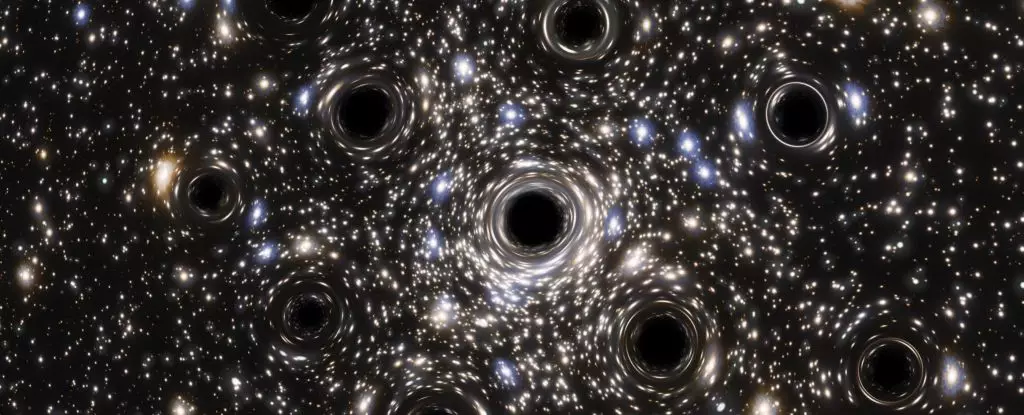In a groundbreaking revelation, astronomers have unveiled compelling evidence pointing to the presence of multiple stellar-mass black holes lurking within Omega Centauri, one of the Milky Way’s most captivating globular clusters. This finding not only challenges previous assertions that suggested the existence of a single, massive black hole at the cluster’s core, but it also opens a Pandora’s box of questions about the evolutionary pathways of black holes. Astronomical research often revolves around understanding the universe’s mysteries, and Omega Centauri, located over 17,000 light-years away, serves as an essential focal point in this quest.
Previously, astronomers believed that the gravitational interactions among stars in Omega Centauri were dominated by a single massive entity, potentially thousands of times the mass of the Sun. However, new insights obtained from a detailed study led by astrophysicist Andrés Banares Hernández and his team indicate that we may be dealing with a swarm of smaller black holes instead. This shift in understanding not only reshapes our conception of Omega Centauri but also contributes to a broader dialogue about the nature of black holes throughout the cosmos.
Omega Centauri is a unique formation, distinguished not only by its size—spanning approximately 150 light-years in diameter—but also by its significant population of stars, estimated at around 10 million. Once believed to be at the heart of a now-defunct dwarf galaxy, the Gaia Sausage, this globular cluster offers a fascinating glimpse into the transitional phases of galactic evolution. Astronomers regard dwarf galaxies as miniature versions of larger galaxies but with markedly different dynamics, particularly concerning black holes.
The idea of intermediate-mass black holes (IMBHs) has captivated scientists for over two decades. These entities, thought to exist in the mass range between stellar-mass black holes and supermassive black holes, provide critical insight into the cosmic architecture. However, finding concrete evidence of IMBHs has proven elusive. The presence of such black holes could bridge significant gaps in our understanding, particularly regarding the formation processes and growth pathways that lead stellar remnants to evolve into supermassive counterparts.
Astrophysical studies often employ rigorous methodologies to glean insights from complex celestial mechanics. In the case of Omega Centauri, researchers have focused their attention on the movement of stars within the cluster, previously analyzed for signs of a single massive black hole. This time, however, Banares Hernández and his team opted to incorporate a novel dataset featuring the accelerations of pulsars—rapidly spinning neutron stars emitting periodic radio waves.
By examining the periodicity of pulsar signals, scientists can gain precise measurements regarding their positions and motions, thus illuminating the movement dynamics within the cluster. As this study revealed, the combined effects of stellar-mass black holes may lead to observable perturbations, suggesting that this celestial nursery is indeed replete with remnants of dying stars that collapsed under their own gravity.
The interpretation of existing data favors the existence of a swarm of smaller black holes rather than a singular IMBH, though the latter cannot be entirely ruled out. This nuanced understanding has implications that could fundamentally reshape our conception of galactic evolution. If stellar-mass black holes coexist with an IMBH, it indicates a possible mechanism for hierarchical merging, where smaller black holes combine over time to form larger structures. This insight aligns with hypotheses about the growth trajectories of supermassive black holes observed at the cores of galaxies.
Moreover, the coexistence theory might explain why formidable black holes evade detection—stellar mass black holes could be gravitationally bound within the disc of an IMBH, thereby complicating efforts to directly ascertain their presence. This revelation invites further investigation to untangle the complex interactions at play in Omega Centauri and similar star clusters scattered throughout the universe.
As scientists grapple with the implications of these findings, the quest for knowledge regarding black holes remains an exhilarating frontier in astrophysics. The established presence of multiple stellar-mass black holes in Omega Centauri is not merely a conclusion; it’s a springboard for future inquiries into the true nature of cosmic darkness. As researchers continue to refine their analytical methods and push the envelope of exploration, the search for elusive IMBHs and the broader conceptual frameworks around black hole formation will undoubtedly hold significant promise for the astronomical community.
In sum, the ongoing studies of Omega Centauri reflect the dynamic nature of scientific inquiry. With every new piece of data, our comprehension of the universe evolves, and the shadows cast by black holes may soon yield to clearer forms, revealing the hidden architectures of the cosmos.

